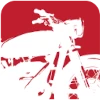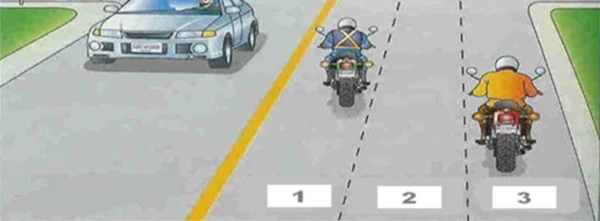 I hear a lot of people talk about motorcycle lane position as if there are rules set in stone and there is only one dominant lane position. The standard agreement is that the left third of the lane is Position 1, the centre of the lane is Position 2, and the right third of the lane is Position 3.
I hear a lot of people talk about motorcycle lane position as if there are rules set in stone and there is only one dominant lane position. The standard agreement is that the left third of the lane is Position 1, the centre of the lane is Position 2, and the right third of the lane is Position 3.

Common Dominant Lane Position
Most people seem to think that P1 is THE dominant position, it's the place that you should be all the time when you're riding alone, and the place where odd numbered members of a group ride would be.
P2 is treated like the Forbidden Zone, it's where the grease and oil from cars ends up, so you should never be there.
P3 seems to be regarded as the place that you should be if you're one of the even numbered riders in a group, or, for some people riding in the left hand lane to block people from taking your lane. Other than that, it's where bicycles are, and a motorcycle shouldn't be there.
Choose a Lane Position to be Seen
This idea doesn't work for me at all, as far as I'm concerned the number one rule for lane position is See and be Seen: Put yourself in whichever spot provides you with the best visibility for each given situation. You can own your lane and be dominate in it from any position inside it, just don't go too far off to either side if you want to avoid having people passing you in your own lane.
Lane Position 2 Can be Dangerous
The idea of the centre of the lane being a 'grease strip' and being unusable doesn't really apply to most of Vancouver Island. It's really only an issue in areas where there is a lot of congestion, and vehicles idling for long periods of time.
The really busy roads in cities tend to have a lot of oil in P2, and you can count on it being at pretty much every intersection, but other than that, it's not that much of a problem around here.
You can see the problem spots in the rain, anywhere that it looks like the water is being repelled, it usually is because of oil. You don't see this happening much on the highways, unless it's new construction and then the whole road tends to be slippery because of the paving process.
I'm perfectly comfortable in P2 most of the time, but you will not find me there approaching a red light, or stop sign.
Lane Position 3 Exposes You to Traffic Behind
P3 has plenty of uses. When approaching a row of oncoming traffic, or even just a large vehicle that blocks the view of what's behind it, moving into the right portion of the lane is the best way to make it so the following people can see you, and hopefully won't decide to pass anyone directly in your path.
P3 is also a great place to be before entering a left hand curve. By being over to the right portion of the road, you can see farther into the turn before committing to it, that way you can look for hazards and have an idea how tight the turn is while you still have time to make corrections. You also should be moving to the right before making right hand turns at intersections to prevent people from getting in between you and the turn you want to make.
My Preferred Lane Position
I personally would rather be in P1 than in P3 when I'm riding in the left lane on the highway so that if someone does decide to take my lane, at least I have almost a whole lane as a safety cushion between me and them so I have more time to react.
The second rule for lane position is that after you have put yourself in a position for a good line of sight, the next thing you need to do is get yourself into the best position to deal with the dangers ahead.
Choose Your Lane Position to Minimize Hazards
Whether the biggest threat to your safety is a patch of gravel in your lane, or an oncoming car that might turn in your path, there are lane positions that you can choose to deal with the threats at hand. See as much as you can to minimize threats, and then move yourself as far away from danger as possible.
See and be Seen Video
This article was contributed by Jeremy of Vancouver Island Motorcycle School
Share This Article
As an old rider, I do have some opinions about this article. Some of my opinions are based upon past experience where I'm fortunate to still be here.
Lanes are usually counted as 1 being the closest to the roadway center line, 2 the next to the right, etc. Automobiles, trucks and so on need no definition beyond this but motorcycles do. Rather than use the terminology "Position", I'll use "Path" to identify the three divisions of a Lane, P1 being on the left, P2 the center and P3 the right.
Group riding is usually practised by motorcyclists as the leader being in either P1 or P3. The 2nd rider in the opposite Path, etc. This is known as a "staggered" formation and it is expected that the 2nd rider will be at least one second behind the leader. The 3rd rider will then be at least 2 s behind the leader ... and so on. While it is legal [BC MVA 194 (10)] to ride two abreast, most riders do not ... it requires a great deal of confidence in the other rider's abilities.
There is no hard and fast rule about which Path a rider may use but rarely will you see an experienced rider in P2 ... Yes, it can be very slippery there especially after a rainstorm.
On a two lane road most will ride in P1 as it gives access to the largest portion of Lane 1 should it be necessary. But moving to P3 to allow a tailgater to pass or where oncoming traffic's vision is impaired, is prudent.
On a multi-lane road, the choices shift. For the moment, I'll ignore the courtesy of "Keep Right Except to Pass". In the case where there is a vehicle in Lane 2, a motorcyclist in Lane 1 will probably be following in P3 because there is a greater probability of being seen in the driver's left side mirror. If the motorcyclist is in Lane 2 following a vehicle also in Lane 2, P1 is the best place to be seen. The same applies with a vehicle in Lane 3 and a motorcyclist in Lane 2 or 3.
A motorcyclist who wants to survive will NEVER assume competence of an automobile driver. Nor, sadly, of most truck drivers. Even if they do look in their mirrors before a sudden lane change, nothing short of 8 feet of chrome seems to register. Most riders will ride ahead or behind adjacent traffic, especially large trucks, because always having an "Escape Route" is a life saver. BTW - Have you ever been beside a semi when a tire blows out? On a bike, it can take you right off.
Perhaps a mention here about the reasoning to permit motorcycles in HOV lanes would be appropriate. It has nothing to do with vehicle occupancy. The reasoning as put forward years ago by the BC Coalition of Motorcyclists was to give a rider a period of protection from the "lane jumper". This was predicated upon the fact that it is illegal to cross a solid white line to enter or exit an HOV lane. Only when the dividing line is broken, is it legal to do so. As such, a rider in the HOV lane could relax their awareness levels when protected by a solid line. Of course in practical terms, this is folly due to the lack of enforcement of "Solid Line" rules and a general ignorance of them, despite signage.
Perhaps 65 years of riding and survival, means something?
- Log in to post comments
Very good (and timely) article on lane position (and nice to see my blue Aerostich suit in print)
My axiom was always "Space, visibility and traction" (an offshoot of what we taught at BCSC), and as noted, position 2 was not the bugaboo that some espouced and actually had advantages in situations like cresting hills.
I always explained lane positions as, 1. somewhere between the left wheel track and the drivers head, if you were driving a car in the driving lane (as opposed to the parking lane, as i often see).
3. between the right wheel track and the passengers head.
2. in the middle of the driving lane.
And during group on road training, students were always taught to ride their own rides, so if single file was the best option over staggered formation (tight curves, right and left turns, narrow streets) they were encouragtd to use it (after appropriate observations and while extending space to maintain a minimum 2 second distance from the person directly in front of them)
When i did the initial drawings for all the manuals, that subtlety sometimes got lost between me and the computer graphics team (that process is a too long, and probably too boring story for most people) thus, i think the rider in position 3 in ther diagram may actually be too far right.
space and visibility bounce back and forth as both priorities and compliments, as sometimes you need more space to be able to see (and be seen), and conversely, you often need maximum lines of sight to tell how much space you have (or what the traction looks like)
And as i often pointed out to my JIBC students, our first goal is to avoid a crash.
And a crash is just a very sudden loss of space.
- Log in to post comments
- Log in to post comments

Motorcycles, Lanes and Paths